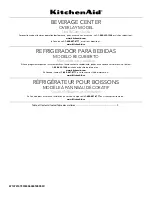
NEED HELP? GIVE US A CALL
855.424.9892
The first step in setting up your appliance is determining what elements are contained in
your water supply. Use one of the options below to determine characteristics of your water.
• Call Your Water Provider - For municipal
water, call your water department to
determine the hardness and pH of your
water supply.
• Test Strips - Follow the instructions on
the provided test strips. If the color on
your test strip is between two readings,
use the higher number. Compare the
colors as soon as you remove them
from your water.
• Hardness Test - The resulting number
gives the hardness in grains per gallon
(gpg) and/or parts per million
(ppm or mg/L).
• Water Pressure - If water is municipally
supplied, the water pressure must be
greater than 20 psi (1.4 bar) and less
than 120 psi (7 bar). If water is from
a well, the water pressure must be
greater than 40 psi (2.8 bar) and less
than 120 psi (7 bar).
• Water Temperature - Not less than 40°
F (4° C) or greater than 120° F (49° C).
• Water Supply Flow Rate - A minimum
of 2.0 gallons (7.6 liters) per minute
is recommended. For the purposes of
plumbing sizing, only the rated service
flow rate and corresponding water
pressure loss may be used. Prolonged
operation of a water softener at flow
rates exceeding the tested service flow
rate may compromise performance.
• pH Test - The pH number is used to rate
the level of acidity or alkalinity of water
soluble substances. Water should have
a pH of 7.
• Testing Laboratory - To ensure
proper settings, have a sample of your
untreated water tested for hardness,
iron and pH. Contact the company of
your choice, or the company below
to conduct a test for you.
National Testing Laboratories, Ltd.
1-800-458-3330
www.watercheck.com.
• Drain - Connect water softener to an
appropriate drain, such as a floor drain
or washer drain that will comply with
all local and state plumbing codes. To
prevent back-siphoning, provide an
adequate air gap or a siphon break. (see
Installation Steps)
• Power Supply - The transformer supplied
is for a standard 110 volt, 60-cycle AC
outlet or 220 volt, 50-cycle AC outlet for
locations outside North America.
• Iron - A common problem found in many
water supplies is iron. It is important to
know what type of and how much iron
is in the water supply.
NOTICE:
If the water supply contains sand, sulfur, bacteria, iron bacteria, tannins, algae, oil, acid, or other
unusual substances, consider pretreating the water to remove these contaminants before the water supply
enters the water softener, unless the water softener is certified to treat these contaminants.
NOTICE:
If ferrous iron is not present in your
water, please skip the next page.
BEFORE YOU BEGIN
6
Test Your Water
Checklist Before Installation








































